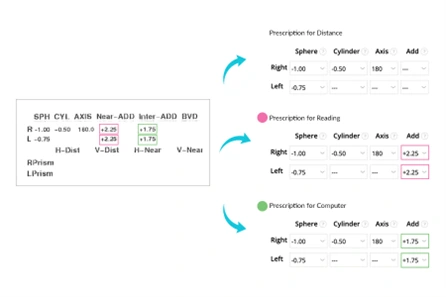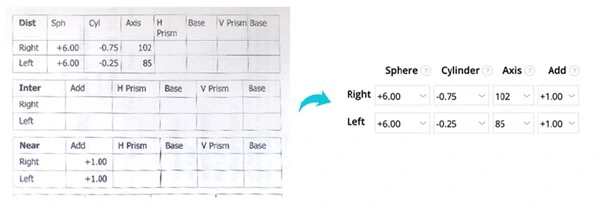Different types of glasses prescriptions
Prescriptions vary per individual. However, there are also different variations of prescriptions.
Single-vision prescription
Single-vision lenses are used in glasses to correct short-sightedness (myopia), farsightedness (hyperopia), and presbyopia, which is a gradual loss of the eye’s ability to focus close up. They use just one prescription and can be used for everyday use, such as reading and driving.
Lined bifocal prescription
Lined bifocal lenses contain two prescriptions. One is for near vision and the other is for distance. The top half of the prescription is usually for distance and the bottom half of the prescription is usually for near vision. Traditional lined bifocal lenses have a clear, visible line to separate prescriptions.
Bifocal prescriptions can be identified on a glasses prescription by numbers in the ADD column.
Progressive or multifocal prescription
Progressive lenses contain three prescriptions: one for distance vision, one for intermediate vision and one for closeup vision. Progressive lenses allow you to experience all three visions without a visible line of separation and are ideal for people who need to use a computer.
This can also be identified on a glasses prescription by the numbers in the ADD column.
How to apply your glasses prescription
A part of understanding your prescription is learning how to enter it when ordering your glasses. Here are some examples of prescriptions provided by opticians and how values should be entered when ordering glasses from Feel Good Contacts.
Specsavers

Vision Express

Boots

NHS

The ADD value will not always be mentioned (or necessary if you’re entering a prescription for distance). In this case, just leave it blank.
Why is my pupillary distance not on my prescription?
Your pupillary distance, also known as PD, is the measurement between the centre of your pupils. It indicates which part of the lens in your glasses you look through.
If you can’t find your pupillary distance on your glasses prescription and think your optician may have made a mistake, rest assured, this information isn’t included on your prescription.
However, you will need this information when ordering your glasses as it is used to ensure your vision is comfortable and clear.
Sometimes your optician will provide you with this information after an examination, however, if they don’t, you can simply measure it yourself using these steps:
- Stand in front of the mirror
- Look straight ahead and place the ruler on the bridge of your nose
- With one hand, make sure that the ruler starts on your right pupil
- Measure the distance between your right pupil and your left pupil
- The number will be your pupillary distance
A glasses prescription may look daunting after your first eye examination, but remember, as long as you understand the symbols and terms, you’ll be able to apply them to your glasses, no matter where you’ve had your eyes examined.
For all your eye care needs, including glasses, sunglasses and contact lenses, shop with Feel Good Contacts.
If you have any questions regarding your glasses prescription, get in touch with our lovely customer service team, who will be more than happy to help you.
Disclaimer: The advice in this article is for informational purposes only and does not replace medical care or an in-person check-up. Please check with an eyecare professional before purchasing any products or remedies. For information on our article review process, please refer to our Editorial Policy.

 Offers
Offers Account
Account
 Favorite
Favorite
 Basket
Basket

 OFFERS
OFFERS



















